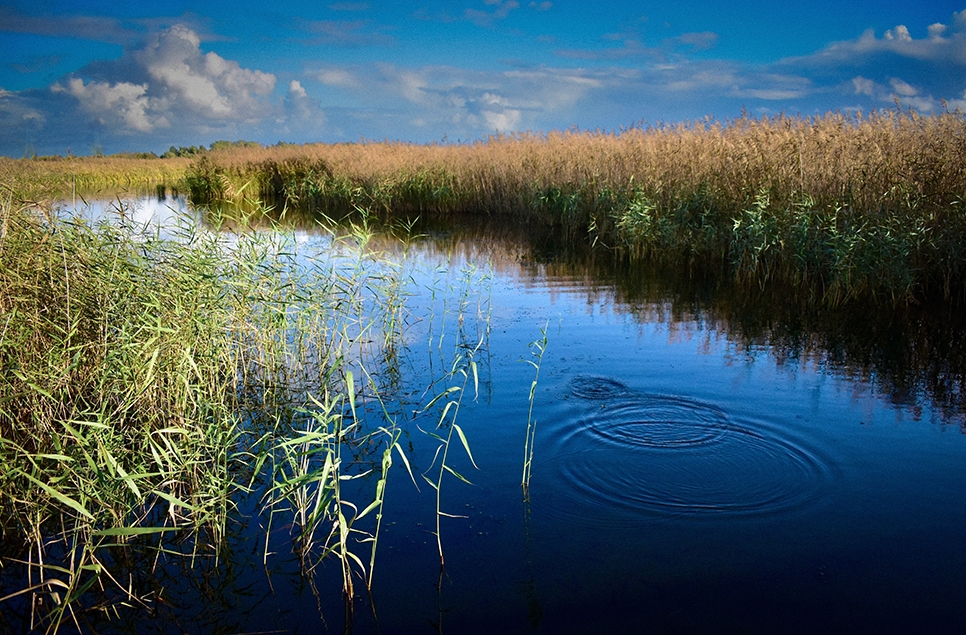Spring on our reserves
Spring is always an exciting time of year in a wetland. Colour, noise and activity are all on the increase as nature shifts into high gear for the breeding season. Thanks to your support we manage our reserves in a way that gives nature the best chance to thrive at this important time. Read on to discover what you might find at your next visit.
Chiffchaffs have been making themselves heard around the reserve at WWT Caerlaverock in the last few weeks, signifying that spring is truly underway. The tree sparrows have been really active too, with birds seen entering our boxes with nesting material.
The Folly pond is providing excellent views of waders, with lots of redshank and a few black tailed godwit and dunlin being seen close up from Sharp’s lookout. Joining them have been shelduck and pintail, which make a nice change from the usual ducks that you might see there. A red kite has also been spotted soaring above the same spot in the car park this spring and a recent highlight has to be the spotting of a hooded crow.
It’s always exciting when the time comes for our first nest box checks of the year. The wet weather has meant a slower start to the season but these weekly checks through spring and summer will hopefully give us some exciting results soon. We’ve been installing new nestboxes on the site with the hope of encouraging barn owl, little owl, kestrel and tree sparrows to use them.

By this time of year at Caerlaverock, we’ve already done a lot of work to improve habitats for specific species. The reserve team have been working on a raft to encourage black headed gulls to breed. We’re planning to put it in the Whooper pond so you’ll get great views if they choose to nest. We’ve also started work on a new pond in the courtyard and whilst draining water out of the old pond we saw some great diving beetles, as well as some other smaller water creatures, which is promising for future pond dipping sessions!
At WWT Washington the reserve team manage a number of diverse habitats across the site for the benefit of wetland wildlife, and in spring, the species on Wader Lake and the saline lagoon really reap their efforts. Settle down in one of the four lakeside hides and marvel at young avocet chicks exploring the exposed mud or learning to fish, alongside gangly grey heron juveniles. The islands here are carefully maintained so as to provide the perfect conditions for these growing birds to thrive. The nearby saline lagoon offers unique 360-degree views of the River Wear and surrounding wildlife, with regular sightings of kingfisher and roe deer, along with the occasional otter if you’re lucky!
This year the team at Washington are working on ways to support the willow tit – the UK’s fastest declining resident bird species. Following ringing sessions earlier in the year specially designed nest boxes have been placed at points around the reserve where the birds have been spotted. The boxes will be closely monitored as the season unfolds, so hopefully we can work out which design best attracts the willow tits and gain a better understanding of their activity. The information will support our reserve teams to manage wetland and woodland habitat to help the species to thrive in the future, something also being undertaken at other sites.

Monitoring of other protected species takes place in spring too, including the monitoring of great crested newts (bottle trapping them and recording their unique belly patterns), Eurasian otters and bats.

At WWT Welney the focus is on water management and monitoring during the breeding season. It’s all about minimising disturbance at this sensitive time of year, whilst keeping an eye on what’s taking place. The team also provide anything they can to support birds and other wildlife, this often means directing water to the most needed areas of the reserve. At different points water levels are important for birds, beetles and wildflowers. Ground nesting birds particularly benefit from these well-cared for wetlands which you have a good chance of seeing from our hides. Important species like black-tailed godwit, redshank, snipe, oystercatcher, little ringed plover, avocet, common tern, garganey, gadwall, shoveler, mute swan, skylark, meadow pipit, yellow wagtail, corn bunting and corncrake to name a few.

It’s not just the birds that benefit. These carefully managed environments support beetles - like the tansy beetle - and wetland specialists such as the yellow loosestrife bee (a solitary bee which lines its burrow with the oil from yellow loosestrife flowers to make it watertight). Also a variety of wetland plants, some of which like to be in or right next to water (marsh marigold, flowering rush, great water parsnip) and some that can be further away from the waterways including purple loosestrife, yellow loosestrife, meadow rue and meadow sweet.
Around the reserve nest box monitoring for small birds such as great and blue tit, house sparrows, robins and wrens, and swallow and house martins is underway. Other ground nesting species – wading birds, ducks, grassland species - are picked up on breeding bird surveys by the reserve team and volunteers, which are done in the early morning when wading birds put on their best displays. As well as hopefully welcoming returning migratory black-tailed godwits both wild reared and head started birds, this year the team are focusing on lapwing. Monitoring for corncrakes takes places after hours when the males’ call can be heard across the wetlands.

Surveying of the moth trap takes place each week on a Wednesday after the light box has been set during the previous night, once the moths have been identified and recorded a selection are available for visitors to see. In addition to this surveys are conducted for dragonflies, butterflies and beetles. Our water vole monitoring will take place over the spring and summer.
You might see the first herds of cattle return to the river banks from Easter, some with young calves. As the breeding season for ground nesting birds starts to wind down the herds are moved onto the washes and further herds are welcomed back to start grazing vegetation, fertilising the soils and ‘poaching’ or muddying up the ditch edges to make insects and seeds available for birds and other wildlife. Wagtails, house martins and swallows feed around the herds because they attract insects. Cattle are kept away from any areas that might be sensitive to nesting activity.

At WWT Llanelli we’re excited to report that kingfishers have started checking out our purpose-made nesting banks. It’s great to see the work the team put in over the winter installing an artificial, wood-clad nesting bank has paid off. The banks will offer protection from predation and from erosion, so we hope they’ll move in to the bank this spring. Your best chance of spotting them during a visit is from the viewing screen in the Deep Water Lake which overlooks the Kingfisher bank.
A family of otters, with three pups, have been making a regular appearance on the reserve. The pups are around three-quarters the size of the mother now and probably around eight months old. The mother raises her cubs without help from the male and will protect them until they're about a year old, when they leave to make their own homes and start to breed around the age of two.
The annual willow tit survey is underway and we’re pleased to report that last week we ringed two willow tits including a female with a brood patch, which means she must be incubating eggs! We’re hoping it’s just the start and our work managing the habitat will help to build the population over the next few years. When you visit you’re most likely to spot them on the Pond Walk loop in the woodland north of the Deep Water Lake.
The team at WWT Arundel are also being kept busy with wildlife surveying. This isn’t just about the birds - there’s monthly water vole monitoring too, which involves the delightful job of checking poo on the water vole latrines.

They’re also keeping tabs on the dormouse nestboxes and checking in regularly with any activity under the grass snake tins.

The team will be surveying for nesting lapwings on the wet grassland too, with an eye out for chicks that will be ringed before they fledge. Any nesting oystercatchers, barn owls and black-headed gull chicks will also be recorded. The monitoring we do at this time of year helps to inform us how we can manage the reserve in the best way for wetland wildlife.

Support from players of People's Postcode Lottery helps us care for our reserves and protect amazing wetland wildlife.

Join us soon to see the spectacular wildlife on our wetlands this spring.
Plan your visit


